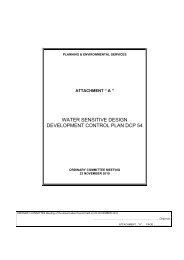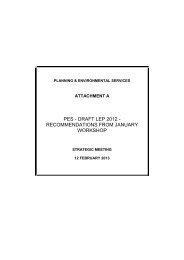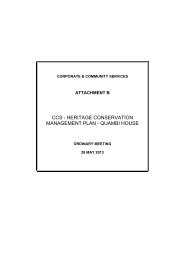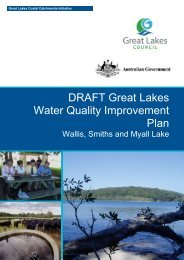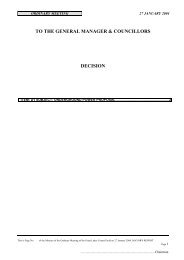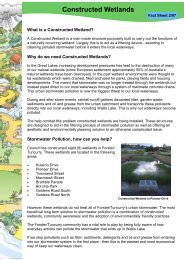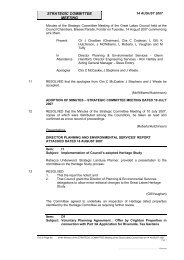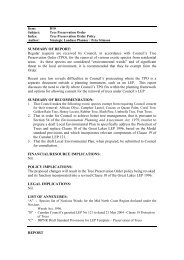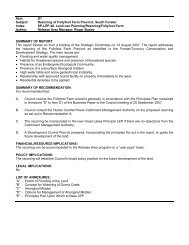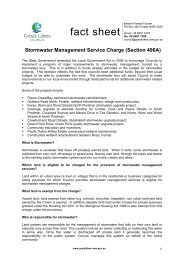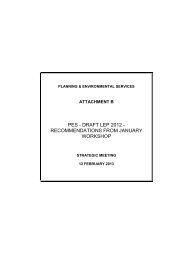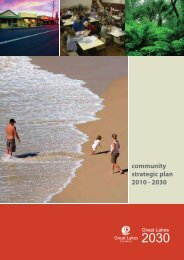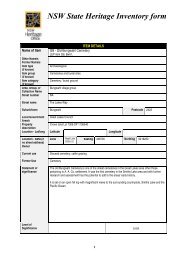13.2 The Wallis Lake Estuary Management Committee - Great Lakes ...
13.2 The Wallis Lake Estuary Management Committee - Great Lakes ...
13.2 The Wallis Lake Estuary Management Committee - Great Lakes ...
Create successful ePaper yourself
Turn your PDF publications into a flip-book with our unique Google optimized e-Paper software.
<strong>Wallis</strong> <strong>Lake</strong> <strong>Estuary</strong> <strong>Management</strong> Plan<br />
13.6 Background to the <strong>Wallis</strong> <strong>Lake</strong> region<br />
13.6.1 History of <strong>Wallis</strong> <strong>Lake</strong> and cultural significance<br />
Two Aboriginal tribes are known to have inhabited the <strong>Wallis</strong> <strong>Lake</strong> region prior to European settlement; the Biripi,<br />
who occupied the area between Tuncurry, Taree and Gloucester, and the Worimi, who occupied the land between<br />
Barrington Tops and Forster and Maitland and the Hunter River in the south. <strong>The</strong> local Aboriginal groups were first<br />
disturbed by early exploring European timber cutters at the beginning of the nineteenth century after permission<br />
was granted to remove cedar from the <strong>Great</strong> <strong>Lake</strong>s region in 1816. At this stage no attempt was at settlement and<br />
the interaction between the early explorers and Aboriginal people was favourable, with the Aboriginal people<br />
guiding some of the explorers over the mountains on occasions.<br />
In 1826 the Australian Agricultural Company trialed a variety of agricultural activities on one million acres of land<br />
selected by the Director, John Macarthur, entirely encompassing the <strong>Great</strong> <strong>Lake</strong>s district. Many of these trials were<br />
unsuccessful due to the moist coastal conditions and in 1832 much of this land, including the <strong>Wallis</strong> <strong>Lake</strong><br />
catchment, was surrendered to the Crown in exchange for grazing land in the Tamworth district.<br />
Land was first granted in Nabiac in 1855, and the area was established as a timber shipping site. Land grants<br />
occurred in Forster in 1856 and in Tuncurry in 1875, with the area supporting the early industries of fishing, timber<br />
cutting and milling, and boat building. <strong>The</strong> local Aboriginal people contributed a considerable workforce to these<br />
early industries in the late 1800s and early 1900s, especially the sheep, cattle, fishing and timber industries. Much<br />
of this early Aboriginal workforce was coordinated through missions and stations and wages were paid into<br />
accounts controlled by successive Governments. But much of this money never actually went to its rightful owners<br />
and the whereabouts of this trust is yet to be located and is currently the subject of a court case between Aboriginal<br />
Elders and the Governments of New South Wales, Queensland and Victoria.<br />
After a brief, albeit unsuccessful attempt at mining gold in the area in 1876, harvesting of natural oyster beds and<br />
leasing of cultivating territories became an important industry for the local economy in the early 1880s. Oyster<br />
aquaculture remains a valuable industry in <strong>Wallis</strong> <strong>Lake</strong> today.<br />
Early tourism began in the area in the 1930s with the local Aboriginal people showing European residents in the<br />
Forster/Tuncurry area where to dive for lobster and abalone. <strong>The</strong> tourism industry has since experienced rapid<br />
growth, especially following the construction of the Forster/Tuncurry road bridge replacing the punt in 1959. <strong>The</strong><br />
tourism and retirement industries now dominate the local economy (Marr 2000).<br />
Today over 100 Aboriginal sites have been identified by the Forster Local Aboriginal Lands Council along the<br />
waterway and foreshore areas of <strong>Wallis</strong> <strong>Lake</strong>. <strong>The</strong>se sites include scarred trees, shell middens, fish traps,<br />
campsites, burial sites and tool sites. However, a complete heritage study of the area is necessary to fully realise<br />
the rich Aboriginal cultural significance of the <strong>Wallis</strong> <strong>Lake</strong> region and foreshores and to formulate protocols with the<br />
Aboriginal community to best protect these areas from future developments.<br />
Sites of significant European heritage in the <strong>Wallis</strong> <strong>Lake</strong> catchment and foreshores are currently being assessed by<br />
GLC through a heritage study to be completed in 2004.<br />
<strong>The</strong> coastal and estuarine area is highly valued by Forster/Tuncurry residents and visiting tourists alike, and<br />
continues to feature prominently in the local Aboriginal culture.<br />
133




